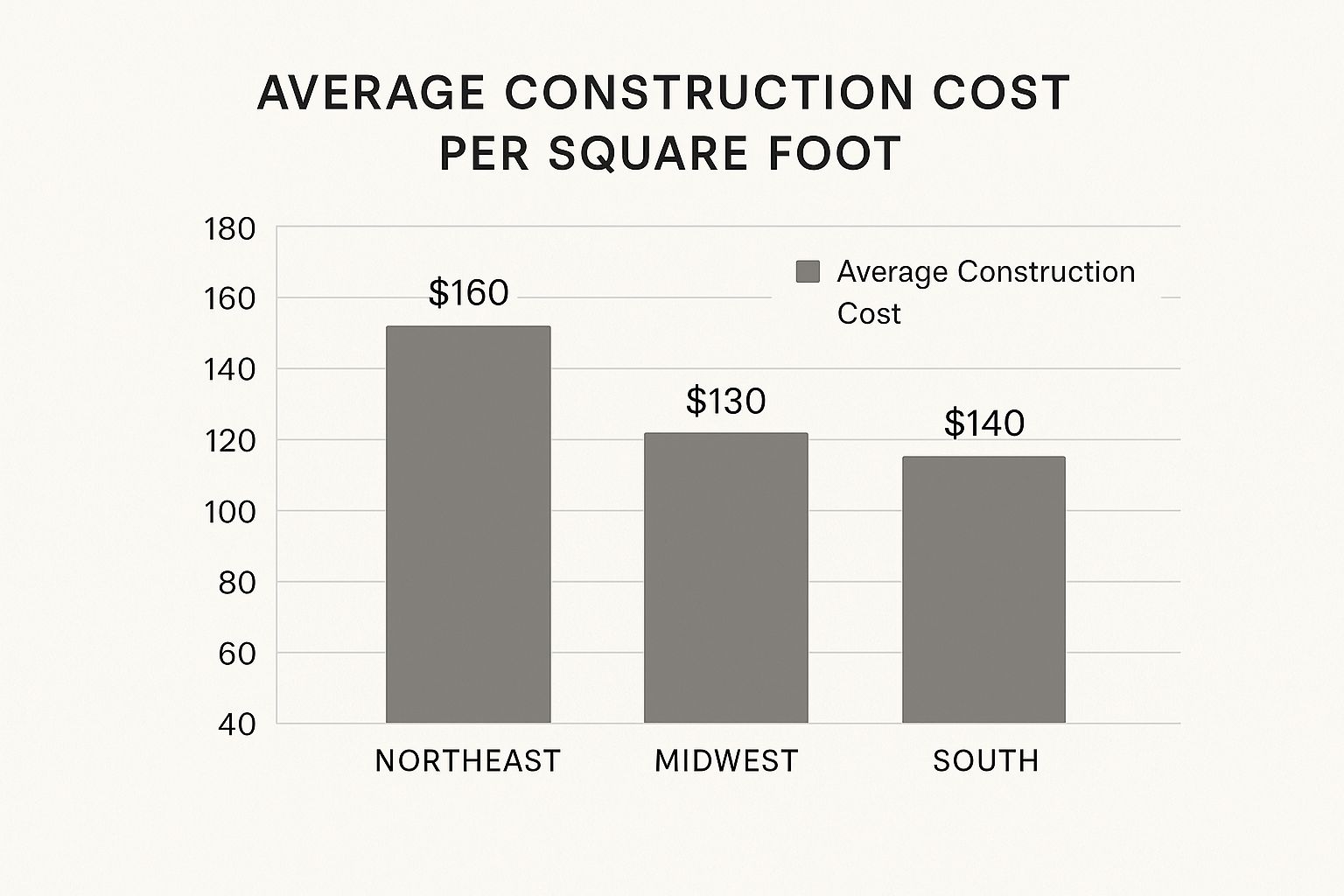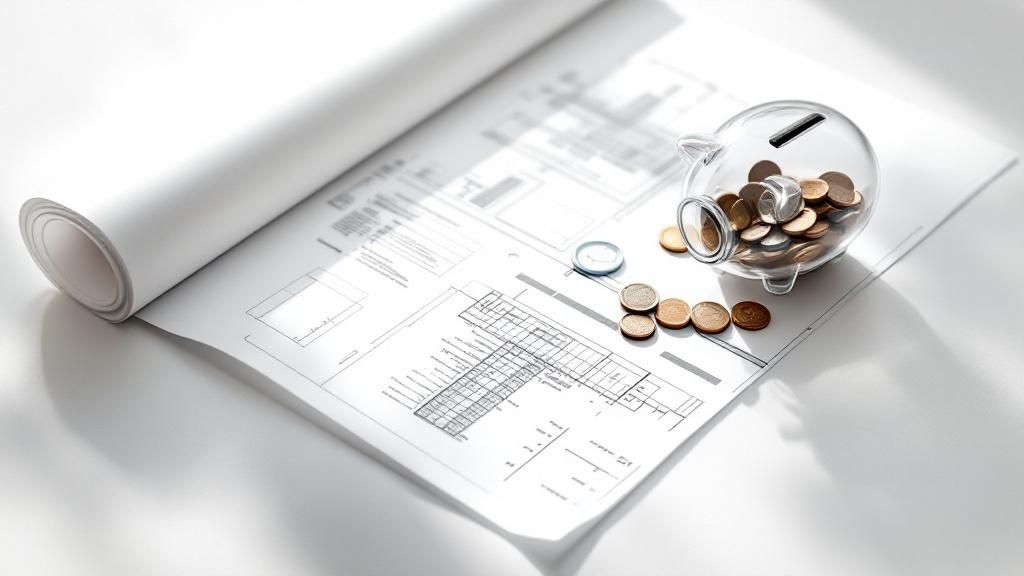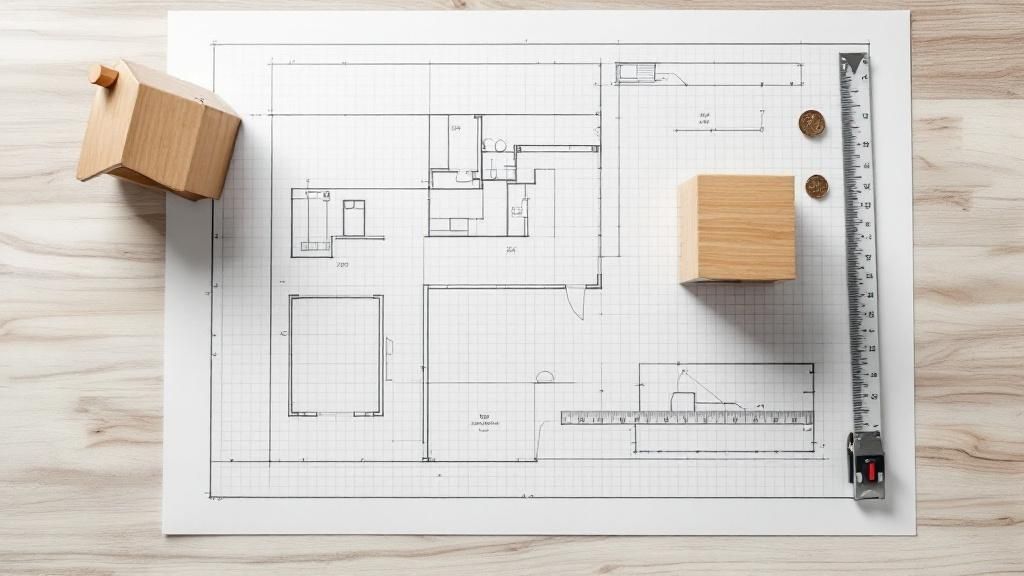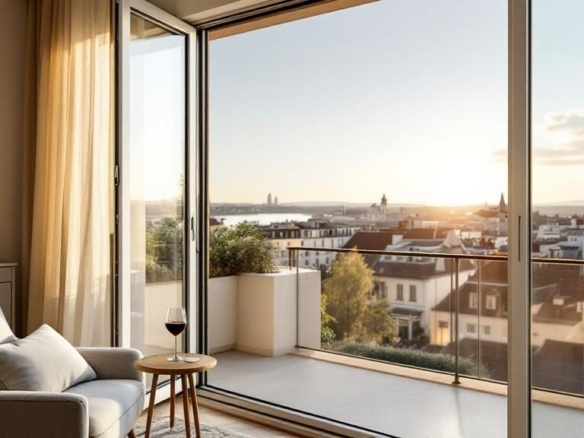For any international investor or developer evaluating a new build, the initial metric is almost always the cost of new home construction per sq ft. It serves as the universal benchmark for project viability, but its simplicity can obscure a complex reality. Understanding the variables behind this figure is paramount for accurate budgeting and successful investment.
As a baseline, a standard-quality new home construction in a market like the United States typically falls between £120 and £200 per square foot ($150-$250). This figure represents the core construction cost—the physical structure itself—before factoring in the significant expenses of land acquisition, premium finishes, or extensive site development. For the discerning investor, this is the foundational number upon which a detailed financial projection is built.
Breaking Down Construction Costs
Whether you are a seasoned developer, a real estate professional advising clients, or a first-time international investor, a granular understanding of the components that constitute the “per square foot” cost is the first step towards a successful project. This is not a single expense but a sophisticated blend of critical cost centres that every builder must navigate.
A comprehensive grasp of this breakdown is essential for effective budgeting, whether you are developing property in the USA, prime European locations, or emerging South American markets. The total expenditure typically segregates into four primary categories:
- Hard Costs: These are the tangible, physical components of the project. They include all building materials—concrete, lumber, steel, wiring—and the skilled labour required to assemble them.
- Soft Costs: These are the essential, non-physical expenses. This category covers architectural designs, structural engineering fees, municipal permits, legal documentation, and other pre-construction services.
- Land Costs: Often a substantial portion of the overall budget, this includes the purchase price of the plot and any necessary preparation work, such as grading, excavation, and utility connections.
- Financing Costs: Unless the project is fully capitalised with cash, this category encompasses all interest, fees, and charges associated with construction loans that fund the project from inception to completion.
A Data-Driven Baseline
To ground this in current market data, let’s examine recent figures for single-family homes in the United States. Amidst rising material and labour prices, the average cost to build a new home has reached a new peak.
Presently, this translates to approximately £130 per square foot ($162) for a typical 2,647 sq ft property. For a more detailed analysis, the National Association of Home Builders (NAHB) provides an excellent, in-depth breakdown of cost allocation.
Here is a simplified overview of how these costs are typically distributed across a project.
Average New Home Construction Cost Breakdown in the USA
This table provides a high-level view of how the total cost of a new single-family home is apportioned across major construction phases.
| Construction Phase | Percentage of Total Cost | Average Cost (USD) |
|---|---|---|
| Site Work & Foundation | 18% | $77,400 |
| Framing | 17% | $73,100 |
| Exterior Finishes | 15% | $64,500 |
| Major Systems (Plumbing, HVAC, Electrical) | 14% | $60,200 |
| Interior Finishes | 25% | $107,500 |
| Other (Permits, Fees, Profit) | 11% | $47,300 |
It is evident that interior and exterior finishes constitute a significant portion of the final price—which is also where an investor has the most control over the budget.
Crucially, this £130 per square foot figure is an average. A luxury custom home in a prime market like coastal California or Miami could easily double or even triple this number. Understanding this baseline is essential before considering regional price differentials and specific material selections.
What Drives Per Square Foot Construction Costs
Knowing the average cost per square foot is merely the starting point. For the sophisticated international investor, a true competitive advantage lies in understanding why this figure fluctuates so dramatically between projects and locations.
The final cost of any new build is a complex amalgam of different expenses. These can be divided into two main categories: the tangible, physical costs, known as hard costs, and the less visible but equally critical soft costs.
Hard costs are the fundamental building blocks of the project. This encompasses everything from the concrete for the foundation and the timber for the framing to the wages paid to skilled tradespeople on-site. They represent the most straightforward element of the budget.
Soft costs, conversely, are the essential services that transform a blueprint into reality. This includes architectural designs, engineering plans, land surveys, and all necessary permits from local authorities. Underestimating these costs is a common pitfall that can lead to significant budget overruns.
The Major Cost Components
When you dissect the budget for a typical new build, the allocation of capital becomes clear. It is not merely about erecting a structure; the finishing touches and essential systems consume a substantial portion of the investment.
A detailed breakdown reveals that interior finishes are the single largest expense, at 24.1% of the total. Following closely are the major systems—plumbing, electrical, and HVAC—at 19.2%. The structural framing accounts for 16.6%, while exterior finishes like roofing and windows comprise 13.4%.
The roof alone is a significant line item; a clearer perspective on this can be gained by examining the average cost for a new roof in the UK. For high-net-worth individuals commissioning a custom property, understanding the right questions to ask luxury home builders before engagement is key to managing these variables.
“Understanding the interplay between material costs and local regulations is where sophisticated investors find their edge. A lower per-square-foot cost in one region might be offset by bureaucratic delays, making a seemingly more expensive market a better long-term investment.”
— Nick Marr, Founder of Homesgofast.com and EuropeanProperty.com
External Market Forces
Project costs are not determined in a vacuum. Broader market dynamics exert immense pressure on construction budgets. Global supply chain disruptions can cause material prices to escalate overnight, while the condition of the local labour market dictates the cost of skilled workers.
Furthermore, regulatory environments play a crucial role. Navigating the complex web of building codes in different countries can add both time and expense to a project. A market with a streamlined permitting process may offer a faster, more predictable path to completion than one mired in bureaucracy—even if initial material costs appear higher. For any global property investor, these external factors are as important as the architectural plans.
A Global Perspective on Regional Cost Differences
The adage “location, location, location” is as critical for determining construction costs as it is for a property’s market value. The disparity in building a luxury villa on the Spanish coast versus a comparable home in a high-growth South American market like Colombia or Uruguay is a product of complex local economic factors.
For any international investor, mastering these regional differences is fundamental. This goes beyond currency conversion; it requires a deep understanding of the economic realities of each market.
- Land Value: Prime land in global hubs like London or New York is exceptionally expensive, adding a massive premium to a project before construction even begins.
- Labour Costs: The cost of a skilled construction crew in Western Europe is substantially different from that in an emerging economy. Local wages and talent availability vary dramatically across the globe.
- Regulatory Hurdles: Developed nations often feature a labyrinth of stringent building codes, environmental regulations, and protracted permitting processes. These “soft costs” can accumulate, causing delays and inflating the final per-square-foot price.
High-Cost Hubs Versus High-Growth Hotspots
The contrast between established and emerging markets is pronounced. Consider the United States, where costs vary significantly even within the country. Major metropolitan areas operate in a different league.
In cities like New York and San Francisco, residential construction costs can easily exceed £400 per square foot ($500), driven by high labour costs and notoriously strict regulations. You can explore these state-by-state variations with detailed 2025 construction market insights.
This chart clearly illustrates the significant variation in construction costs just within the USA.

As shown, location is paramount. The Northeast is consistently more expensive than the Midwest or the South, demonstrating that even domestic projects demand a keen focus on regional economics.
Comparative Construction Costs Per Square Foot Across Global Markets
To fully appreciate the global landscape, let’s compare construction costs across different international markets. The table below provides a snapshot, contrasting estimated per-square-foot costs and their key drivers, from premium hubs to promising emerging regions.
| Region / City | Estimated Cost Per Sq Ft (Low End) | Estimated Cost Per Sq Ft (High End) | Key Influencing Factors |
|---|---|---|---|
| New York, USA | £360 ($450) | £560+ ($700+) | High land value, union labour, stringent regulations |
| London, UK | £320 ($400) | £520+ ($650+) | Prime real estate, complex planning, high material costs |
| Tokyo, Japan | £280 ($350) | £480 ($600) | Seismic codes, skilled labour scarcity, premium materials |
| Sydney, Australia | £200 ($250) | £360 ($450) | High labour wages, supply chain costs, land scarcity |
| Dubai, UAE | £120 ($150) | £240 ($300) | Imported materials, luxury finishes, rapid development |
| Lisbon, Portugal | £95 ($120) | £200 ($250) | Rising labour costs, tourism boom, foreign investment |
| Bogotá, Colombia | £65 ($80) | £145 ($180) | Lower labour costs, local materials, growing economy |
This comparison underscores that the rationale behind the numbers is as important as the numbers themselves. A market’s economic maturity, regulatory environment, and local resource availability create a unique cost profile for builders and investors.
What’s Driving the Numbers?
These cost differentials present distinct opportunities. A high per-square-foot cost in a city like Geneva or Tokyo is not inherently negative; it often indicates a stable, mature market where an investment holds strong potential for long-term value appreciation.
Conversely, a lower cost of new home construction per sq ft in a high-growth region like the southern USA or parts of South America can signal an opportunity for higher returns. However, these markets often carry their own risks, such as economic instability or unpredictable regulatory frameworks.
For the astute investor, the objective is not simply to find the cheapest location to build. It is to identify the market where the cost-to-value ratio aligns perfectly with their financial objectives. This requires looking beyond headline figures and delving into the economic forces that shape each region’s construction landscape.
How Design And Materials Shape Your Final Budget

Once land and labour costs are accounted for, the two most significant levers for managing your cost of new home construction per sq ft are architectural design and material selection. These elements are where vision converges with budget, necessitating a series of strategic trade-offs.
Every decision, from the complexity of the roofline to the type of flooring installed, has a direct and immediate impact on the bottom line. It is a classic balancing act between aesthetic ambition and fiscal prudence.
Consider architectural complexity a cost multiplier. A simple, rectangular structure is the most cost-effective to build. The moment you introduce custom gables, curved walls, or other non-standard geometries, you also introduce additional costs for materials, specialised labour, and extended construction timelines. Each additional corner adds to the total cost.
From Standard-Grade To Luxury Finishes
The chasm between standard and luxury finishes is where a budget is truly made or broken. This is not merely an aesthetic distinction; the cost differential is substantial and multiplies rapidly across every room. For any investor, knowing where to allocate capital for maximum impact is critical.
Consider these common examples:
- Flooring: Standard vinyl or quality laminate costs a fraction of reclaimed hardwood or imported natural stone.
- Countertops: Laminate is the default for budget-conscious builds, whereas custom-cut Italian marble can become one of the most significant line items in a kitchen budget.
- Fixtures: Basic chrome taps and light fittings are modestly priced, but designer brass faucets and integrated smart-lighting systems will cause costs to escalate significantly.
For those beginning to outline these decisions, our guide on how to prepare for a home construction project offers a solid framework for organisation.
The Long-Term Value Of Smart Investments
It is tempting to select the most economical options to minimise initial build costs. However, experienced investors understand that strategic upgrades can yield returns many times over. Investing in high-performance, energy-efficient materials is a prime example.
Choosing superior insulation, triple-glazed windows, or a high-efficiency HVAC system will increase the upfront construction cost per square foot. However, these choices deliver tangible savings year after year through lower utility bills and can significantly enhance the property’s resale value.
Today’s buyers are sophisticated. They seek properties with lower running costs and a reduced environmental footprint. Incorporating sustainable building materials can also add significant long-term value and market appeal. Ultimately, the optimal strategy involves aligning design and material choices with both immediate budget constraints and long-term investment objectives. This is the hallmark of a successful build.
Understanding Builder Profits and Market Pressures
To gain a comprehensive understanding of the cost of new home construction per sq ft, a savvy investor must look beyond the price of materials and labour. It is essential to understand the builder’s business model—their profit margins, overheads, and the market forces that influence them.
A builder’s quotation is not merely the sum of raw materials and crew wages. Embedded within that final figure is a critical markup that covers their business overheads—office rent, insurance, staff salaries, and marketing—and their profit margin, which is their compensation for undertaking the risk and complexity of the project.
This profit margin is not static; it fluctuates with market conditions. In a high-demand market, builders can command higher margins. Conversely, during a downturn, they may reduce profits to remain competitive and maintain workflow.
The Ripple Effect of Economic Trends
The broader economic climate significantly impacts construction costs. Inflation affects not only consumer goods but also drives up the cost of everything from concrete to copper wiring. These increases are invariably passed on to the client.
A recent survey from the NAHB illustrates this perfectly: construction costs now constitute a staggering 64.4% of a new home’s price in the U.S., the highest level since 1998. This demonstrates how soaring material and labour prices are impacting budgets and final sale prices. You can explore the full NAHB construction cost data to see these trends firsthand.
Navigating Cost Fluctuations
Understanding the construction business provides a significant strategic advantage. When reviewing a builder’s quote, you can begin to identify which costs are fixed and which may have room for negotiation.
Understanding a builder’s financial model allows for more effective discussions. It shifts the conversation from simply asking for a lower price to strategically managing costs where flexibility exists, such as in finish selections or project phasing.
Recognising that external economic forces can shift the parameters also underscores the importance of a robust financial plan. For investors financing their build, monitoring market trends is crucial. Positive developments like falling fixed-rate mortgage deals could present an opportune moment to secure favourable terms. This insider’s perspective enables you to move with the market, not against it, thereby protecting your investment.
Smart Ways to Manage Your Construction Budget

Synthesising all cost variables into a coherent financial plan is the final—and most critical—step for any investor. While the cost of new home construction per sq ft is a multifaceted challenge, a disciplined strategy is what distinguishes a successful project from a fraught one. Through meticulous planning, you can transform unpredictable variables into manageable outcomes.
This image from Homesgofast.com exemplifies why market awareness is vital. It displays a range of existing properties, providing a real-world benchmark for your new build. How does your projected cost compare to what is already on the market? Answering this question helps validate your budget and estimate potential resale value from the outset.
How to Protect Your Investment
Effective budget management is about foresight and intelligent decision-making. It is not simply about securing the lowest price, but about creating enduring value. For a more detailed exploration, these effective construction cost management strategies offer excellent, in-depth advice.
To keep your project on track and maximise your return on investment, focus on these core tactics:
- Secure Competitive Bids: Never accept the first quotation. Obtain at least three detailed bids from thoroughly vetted builders. This not only ensures a competitive price but also provides a clear snapshot of current market rates for labour and materials.
- Establish a Substantial Contingency Fund: In construction, unforeseen events are a certainty. A contingency fund is not optional; it is essential. Allocate 10-20% of your total budget to cover unexpected costs without derailing the entire project.
- Invest Where It Counts: Allocate capital to features that deliver a tangible return on investment. Prioritise upgraded kitchens, high-quality bathrooms, and energy-efficient systems. These elements add far more to the final sale price than purely cosmetic enhancements.
- Consider Phased Construction: Is a swimming pool or elaborate landscaping essential from day one? A phased approach is a prudent way to manage cash flow. Complete the primary structure first, then add high-cost amenities later as finances permit.
Ultimately, mastering the cost of new home construction per sq ft is not about finding a single magic number. It is about diligent, hands-on management at every stage of the process.
Frequently Asked Questions
When delving into new construction, particularly as an international investor, several key questions consistently arise. Here are concise answers to the most common queries regarding the cost of new home construction per sq ft.
Does The Cost Per Square Foot Include The Price Of Land?
In short, no. When builders and contractors quote a ‘cost per square foot,’ they are almost exclusively referring to the ‘vertical’ construction—everything from the foundation upwards. The land is a separate, significant investment. The price of the finished plot, including the raw land and all necessary site preparation and utility connections, must be calculated independently within your overall project budget.
How Much Should I Budget For A Contingency Fund?
This is a critical question, and the answer is unequivocal: do not omit it. For any new build, it is prudent to establish a contingency fund of at least 10% to 20% of your total estimated construction cost. This is your financial safety net for the inevitable surprises, such as discovering challenging soil conditions, a sudden spike in material prices, or a mid-project design change. A robust contingency fund is your best defence against budget overruns.
Are Modern Prefabricated Homes Cheaper Per Square Foot?
Often, yes—but it is not a guarantee. Prefabricated or modular homes can offer superior value per square foot compared to traditional ‘stick-built’ houses due to efficiencies in a controlled factory environment, which reduces material waste and optimises labour. However, the final price is contingent on several factors:
- Level of Customisation: The more you deviate from standard designs, the higher the cost.
- Quality of Finishes: Opting for high-end appliances, countertops, and fixtures can easily elevate the price to that of a custom build.
- Transportation & Assembly: The costs of transporting modules to your site and professional assembly must be factored in.
While base models are typically more economical, a fully customised, high-end modular home can ultimately cost as much as a site-built one. A careful comparison of detailed quotes is always advisable.
About Homesgofast.com
HomesGoFast.com is a leading international property website, established in 2002, helping homeowners, real estate agents, and developers reach overseas buyers. Featuring thousands of listings from over 50 countries, the platform connects global property seekers with homes, apartments, villas, and investment opportunities worldwide.
Looking for expert mortgage guidance? Get international property mortgage advice here:
👉 https://homesgofast.com/mortgages-overseas/
Explore more overseas homes for sale at our global partner site:
👉 https://homesgofast.com/overseas-property/
Looking to sell real estate to foreign buyers
https://homesgofast.com/sell-overseas-property/




